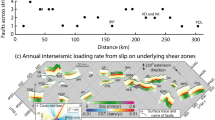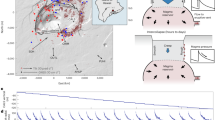Abstract
—Observations of accelerating seismic activity prior to large earthquakes in natural fault systems have raised hopes for intermediate-term earthquake forecasting. If this phenomena does exist, then what causes it to occur? Recent theoretical work suggests that the accelerating seismic release sequence is a symptom of increasing long-wavelength stress correlation in the fault region. A more traditional explanation, based on Reid's elastic rebound theory, argues that an accelerating sequence of seismic energy release could be a consequence of increasing stress in a fault system whose stress moment release is dominated by large events. Both of these theories are examined using two discrete models of seismicity: a Burridge-Knopoff block-slider model and an elastic continuum based model. Both models display an accelerating release of seismic energy prior to large simulated earthquakes. In both models there is a correlation between the rate of seismic energy release with the total root-mean-squared stress and the level of long-wavelength stress correlation. Furthermore, both models exhibit a systematic increase in the number of large events at high stress and high long-wavelength stress correlation levels. These results suggest that either explanation is plausible for the accelerating moment release in the models examined. A statistical model based on the Burridge-Knopoff block-slider is constructed which indicates that stress alone is sufficient to produce accelerating release of seismic energy with time prior to a large earthquake.
Similar content being viewed by others
Author information
Authors and Affiliations
Additional information
Received October 3, 1999; revised May 5, 2000; accepted May 5, 2000
Rights and permissions
About this article
Cite this article
Winter, M. The Plausibility of Long-wavelength Stress Correlation or Stress Magnitude as a Mechanism for Precursory Seismicity: Results from Two Simple Elastic Models . Pure appl. geophys. 157, 2227–2248 (2000). https://doi.org/10.1007/PL00001082
Issue Date:
DOI: https://doi.org/10.1007/PL00001082




